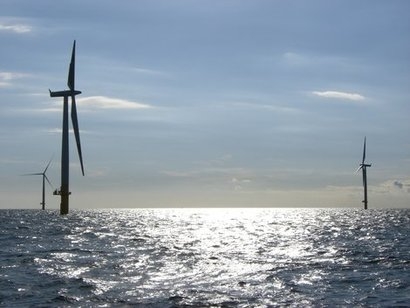
The study has found that nearly half the offshore wind projects needed to reach the government's 2030 target are only at concept stage. Such projects typically take 13-plus years to move from concept to operation, many far longer. This is largely due to delays in government planning and approval processes.
It means the UK is at risk of missing the target unless installations accelerate.
It comes just days after Boris Johnson, the outgoing Prime Minister, highlighted the importance of offshore wind to the UK’s future energy supplies, commenting that offshore wind is now nine times cheaper than gas during a speech he made on Thursday.
The findings will be contained in OEUK’s Economic Report: A Focus on UK Energy Security, due for publication on Wednesday, September 7.
It will take a detailed look at the UK’s energy security landscape, including gas, oil, and offshore wind, pointing the new government to the nation’s key strengths and vulnerabilities. At the moment the UK gets 19 percent of its total energy as electricity but demand for power is projected to increase by 50 percent by 2035 as electric vehicles replace petrol and diesel ones, and heat pumps replace domestic boilers.
Many of the companies producing oil and gas are the same ones investing in renewable energy and delivering the critical supply chain work needed to build offshore wind projects. Offshore wind will also play a crucial role in generating clean electricity to power offshore platforms – sharply cutting the emissions from UK oil and gas production.
The UK has 2,500 offshore wind turbines which produced 12 percent of the nation’s electricity last year.
Nuclear generated 15 percent of UK electricity. Both are small compared to gas which was used to generate 40 percent of UK power.
About half the gas used in the UK is imported, making the UK reliant on global markets, vulnerable to shortages and at risk of the kind of price shocks that have already sent energy bills soaring.
However, in April, Boris Johnson’s British Energy Security Strategy announced plans to make the UK “the Saudi Arabia of wind power” with a four-fold expansion of offshore wind by 2030.
The UK already has the world’s second largest installed offshore wind capacity, at around 12 GW. The strategy aims to increase it to 50 GW by 2030, of which at least a tenth is to take the form of floating wind farms.
This capacity would be enough to power every home in Britain provided the wind is blowing. It would support the UK target of reaching carbon neutrality or ‘net zero’ by 2050.
Expanding offshore wind would also give the UK more control over its own energy sources – cutting import bills, boosting energy security, and reducing the risk of energy shortages and rationing during future crises.
The challenge of the government's planned expansion is huge. It means the UK will need to install an estimated 3,200 new, and much larger, wind turbines by 2030 – roughly three new turbines every two days.
OEUK’s report will say this is achievable but only if the government removes regulatory and planning delays. These mean, for example, that it currently takes four years simply to gain planning consent for new projects.
“As of late August, OEUK knew of around 40 projects planned through to 2030 at various stages of the development cycle” said Ross Dornan, lead author of OEUK’s Economic Report. “Based on this pipeline, the Energy Security Strategy target is potentially achievable, but it is important to understand the associated project uncertainties and risks. This scale of installation is very ambitious, and it will require significant improvements to the regulatory and permitting process. Of the potential capacity additions before 2030, 46 percent (almost 18.5 GW) is only at concept stage. History shows that it takes around 13 years to progress from concept and application stage through to operations. This means that the UK’s 50 GW ambitions will only be achieved if this can be sped up.”
OEUK’s Economic Report will call on the UK’s new government to implement four key measures from its Energy Security Strategy to boost the rate of offshore wind installations.
Cut planning consent times from four years to one.
Streamline the Environmental Assessment process
Cut red tape using the government’s Offshore Wind Acceleration Task Force
Create a fast-track planning process for non-controversial projects
Mr Dornan added that the UK’s offshore industry could achieve many of the government’s targets – but only if those changes were introduced fast.
“Our sector is showing how its vital skills and expertise can drive the low-carbon energy and emissions solutions needed for the future” Mr Dornan said. “We’re seeing that in action in the North Sea, through the start-up of power generation at the Seagreen offshore wind project and the beginning of construction of the Dogger Bank project – two of the world’s largest offshore wind farms which are both being led by companies with an oil and gas production heritage. As we have learned over the last year, energy is a precious resource which must be properly managed, in the short and long term. Our sector has many of the answers and through constructive work with governments and regulators, we can boost the UK economy, cut emissions, secure jobs and most important, heat and power homes and industries with energy produced here, for decades to come.”
For additional information:

